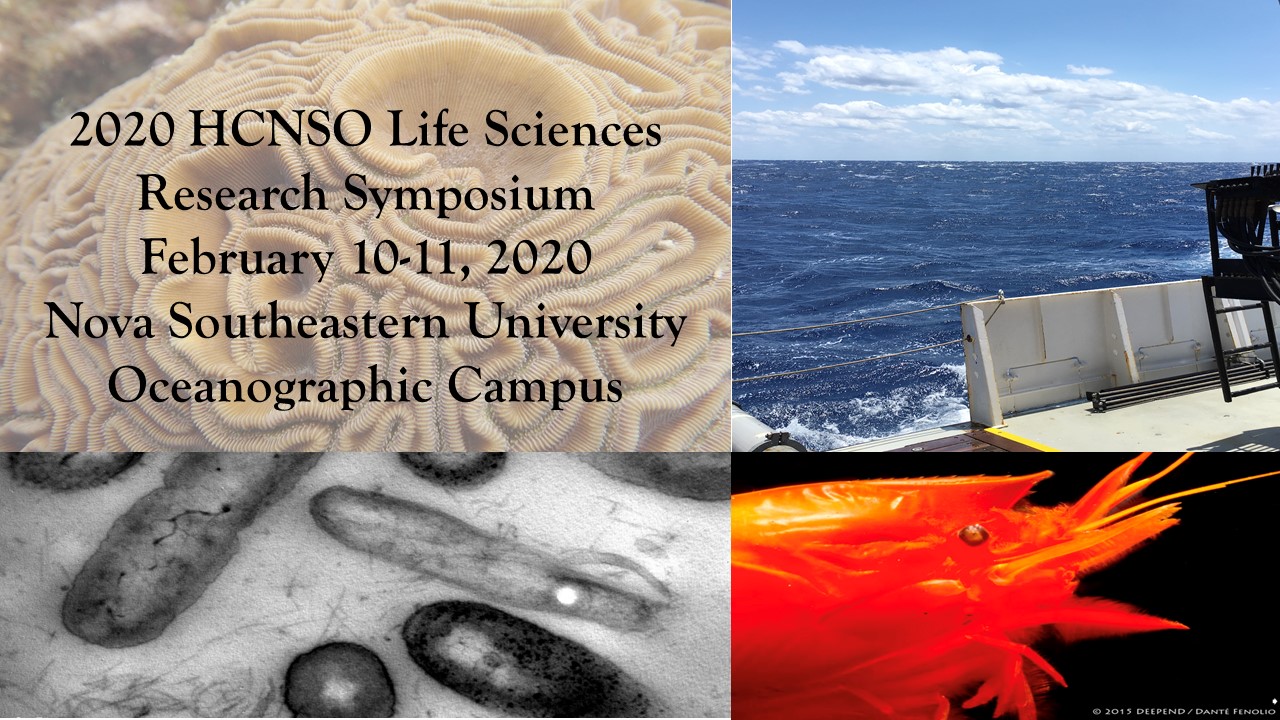Linking crude oil and dispersant effect to the genetic expression of marine sponge Cinachyrella
Location
HCNSO Guy Harvey Oceanographic Center Nova Southeastern University
Start
2-10-2020 2:15 PM
End
2-10-2020 2:30 PM
Type of Presentation
Oral Presentation
Abstract
Oil, a natural polyaromatic hydrocarbon, is in increasing demand in this non-stopping growing world. With the race to extraction comes risks, among which oil spills are the most impactful. Oil spills environmental impacts can be seen throughout the entire water column, and typically have a negative impact on most biological taxa within ecosystems. To understand the effects of oil spills and dispersant on marine life, as well as on humans, studies should focus on the impact of such chemicals at the genetic scale. Here, we study the effects of oil and dispersant on the gene expression (transcriptome) using a South Florida and Caribbean reef marine sponge,Cinachyrella sp., a developing model marine organism. The major goal of this project was to show that gene expression is significantly affected in a new indicator sponge species after an acute environmental stress (oil and dispersant). This will complete a study began after the 2010 Deepwater Horizon Oil Spill (DWHOS). Preliminary data showed the toxic effects of crude oil and dispersant on Cinachyrella tissue, but not its microbiome. I have applied new and improved transcriptomic and bioinformatics tools to characterize and quantify the effects of oil, dispersant and oil:dispersant mixtures on the gene expression of experimental model sponges. Using a relatively novel RNA-Seq kit (Lexogen QuantSeq 3’ mRNA-Seq), 21 transcriptome libraries from each treatment have been compared.Sequenced libraries yielded 7.8 million reads per sample on average, and current analyses return a total of >21000 genes with notable expression levels. Whole transcriptome sequencing of three environmental samples yielded one transcriptome consisting of >200,000 mono-coding genes, most of which are not related to the sponge. On the other hand, about 36,459 genes matched the sponge A. queenslandica annotation in which 8,581 genes were flagged as uncharacterized proteins. Ultimately, this project aims to better understand the effect of such chemicals at the genetic scale of an organism and potentially establish the sponge model as both a bio-indicator of water quality in the south Florida waters as well as a new potential lab model intended for research purposes.
Linking crude oil and dispersant effect to the genetic expression of marine sponge Cinachyrella
HCNSO Guy Harvey Oceanographic Center Nova Southeastern University
Oil, a natural polyaromatic hydrocarbon, is in increasing demand in this non-stopping growing world. With the race to extraction comes risks, among which oil spills are the most impactful. Oil spills environmental impacts can be seen throughout the entire water column, and typically have a negative impact on most biological taxa within ecosystems. To understand the effects of oil spills and dispersant on marine life, as well as on humans, studies should focus on the impact of such chemicals at the genetic scale. Here, we study the effects of oil and dispersant on the gene expression (transcriptome) using a South Florida and Caribbean reef marine sponge,Cinachyrella sp., a developing model marine organism. The major goal of this project was to show that gene expression is significantly affected in a new indicator sponge species after an acute environmental stress (oil and dispersant). This will complete a study began after the 2010 Deepwater Horizon Oil Spill (DWHOS). Preliminary data showed the toxic effects of crude oil and dispersant on Cinachyrella tissue, but not its microbiome. I have applied new and improved transcriptomic and bioinformatics tools to characterize and quantify the effects of oil, dispersant and oil:dispersant mixtures on the gene expression of experimental model sponges. Using a relatively novel RNA-Seq kit (Lexogen QuantSeq 3’ mRNA-Seq), 21 transcriptome libraries from each treatment have been compared.Sequenced libraries yielded 7.8 million reads per sample on average, and current analyses return a total of >21000 genes with notable expression levels. Whole transcriptome sequencing of three environmental samples yielded one transcriptome consisting of >200,000 mono-coding genes, most of which are not related to the sponge. On the other hand, about 36,459 genes matched the sponge A. queenslandica annotation in which 8,581 genes were flagged as uncharacterized proteins. Ultimately, this project aims to better understand the effect of such chemicals at the genetic scale of an organism and potentially establish the sponge model as both a bio-indicator of water quality in the south Florida waters as well as a new potential lab model intended for research purposes.


